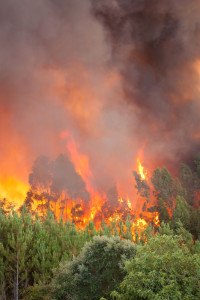A new study of Western forest fires confirms what is already apparent – wildfire seasons are getting longer and more destructive.
But researchers with the University of Idaho and Columbia University also say humans are to blame.
The study made public Monday says human-caused global warming contributed an additional 16,000 square miles of burned forests from 1984 to 2015.
Researchers say the 16,000 square miles represent half of the forest areas that burned over the last three decades.
 “We’re no longer waiting for human-caused climate change to leave its fingerprint on wildfire across the western U.S.,” John Abatzoglou, the study’s lead author and an associate professor of geography at the University of Idaho, said in a statement. “It’s already here.”
“We’re no longer waiting for human-caused climate change to leave its fingerprint on wildfire across the western U.S.,” John Abatzoglou, the study’s lead author and an associate professor of geography at the University of Idaho, said in a statement. “It’s already here.”
The authors of the study, published online in the Proceedings of the National Academy of Sciences, say it’s the first to try to quantify how much human-caused climate change has increased wildfires in Western forests. Some other factors that had to be considered as contributing to the increase, the report said, included a legacy of fire suppression in the West, natural climate variability, and human settlement.
The study found that longer and hotter dry spells are causing Western forests to dry out and become more susceptible to wildfires.
Specifically, researchers said, spring and summer temperatures have warmed by 2 to 2.5 degrees since 1950. Researchers said that warming accounts for 55 percent of what they call “fuel aridity” from 1979 to 2015. The study attributed the other 45 percent to natural climate variations.
The study found that since 2000 there’s been a 75 percent increase in forested lands with elevated aridity and nine more days each year with dry forests especially susceptible to wildfires.
“Anthropogenic climate change has emerged as a driver of increased forest fire activity,” the report says.
Park Williams of Columbia University’s Lamont-Doherty Earth Observatory, and a co-author of the study, said the report provides a better understanding of the effects human-caused global warming has on Western forests.
“This knowledge will allow us to make more educated fire and land management decisions,” he said.
One of those decision-makers is Idaho Forester David Groeschl, who said the report could offer some help in the future.
“We know that our fire season is getting longer,” Groeschl said. “We know that we’re seeing more and longer fires, and we know that we have increasing fuels out there as well.”
The fuel aridity was particularly bad in Idaho in 2015 when an extended heat and drought left northern Idaho forests parched and in the worst condition since 1926, officials said.
That summer and fall, 600 square miles of U.S. Forest Service land burned. Idaho’s bill for fighting wildfires soared to $60 million with some 100 square miles, about three quarters of it forests, burning on state, private and federal lands that are in forest protective districts designated as the state’s responsibility.
Idaho has taken a number of steps aimed at the wildfire risk, including increasing the pay of in-demand, experienced firefighters who were leaving to take similar jobs with more money at other agencies. Idaho also recently formed a partnership with the U.S. Forest Service to take on landscape-scale projects by using the state’s land management expertise that includes selling timber on federal land. The state’s first auction of federal timber took place last month.
How successful the partnership will take years to determine.
The study released Monday concluded that the trend of increased forest aridity resulting in large wildfires is likely to continue for decades while there are enough trees to fuel the flames.
Was this article valuable?
Here are more articles you may enjoy.

 Cat Bonds Linked to Wildfires Lose ‘Once Untouchable’ Status
Cat Bonds Linked to Wildfires Lose ‘Once Untouchable’ Status  Instacart to Pay $60 Million in FTC Consumer Protection Case
Instacart to Pay $60 Million in FTC Consumer Protection Case  ‘Door Knocker’ Roofers Were Everywhere. NC Farm Bureau Saw an Opportunity
‘Door Knocker’ Roofers Were Everywhere. NC Farm Bureau Saw an Opportunity  J&J Talc Jury Awards $1.56 Billion to Asbestos Cancer Victim
J&J Talc Jury Awards $1.56 Billion to Asbestos Cancer Victim 